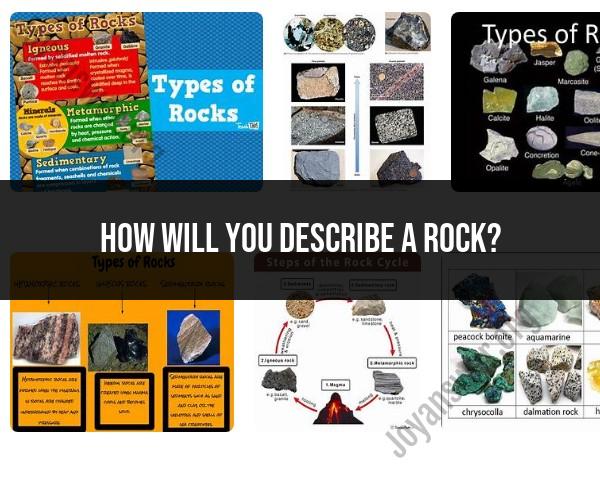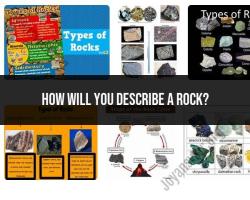How will you describe a rock?
Describing a rock involves providing information about its type, characteristics, and formation. Here's a guide on how to describe a rock effectively:
Type of Rock:
Begin by identifying the type of rock you are describing. Rocks fall into three main categories: igneous, sedimentary, and metamorphic.
Igneous Rock: Mention if the rock is igneous, which means it formed from the solidification of molten magma or lava. Igneous rocks can be further classified into intrusive (formed beneath the Earth's surface) and extrusive (formed on the Earth's surface) types.
Sedimentary Rock: If the rock is sedimentary, explain that it formed from the accumulation and compaction of sediments, such as sand, mud, or organic material. Mention any distinctive features like layers, fossils, or ripple marks.
Metamorphic Rock: If the rock is metamorphic, indicate that it originated from pre-existing rocks that underwent changes due to heat, pressure, or chemical processes. Mention any signs of foliation (layering) or mineral recrystallization.
Composition:
- Describe the rock's mineral composition. Identify any minerals present, and note their relative proportions. Some rocks are primarily composed of a single mineral (e.g., quartzite), while others contain a mixture of minerals (e.g., granite).
Texture:
- Discuss the texture of the rock, which refers to the size, shape, and arrangement of mineral grains or particles.
- For igneous rocks, mention whether it is fine-grained (small crystals) or coarse-grained (large crystals).
- In sedimentary rocks, describe the grain size (e.g., fine sandstone, coarse conglomerate) and any visible features like fossils or cross-bedding.
- In metamorphic rocks, describe the texture as foliated (layered) or non-foliated (lacks layering).
Color:
- Provide information about the rock's color. Note any variations or distinctive color patterns.
- Mention whether the color is due to the presence of specific minerals or mineral impurities.
Hardness:
- Discuss the hardness of the rock. You can use the Mohs scale of mineral hardness to provide a relative measure of hardness.
Density and Weight:
- Mention the rock's density and weight. Some rocks are denser and heavier than others due to their mineral composition.
Formation:
- Explain the geological processes that led to the formation of the rock. Describe the rock's geological history, including any significant events or changes it underwent.
Location:
- If known, specify where the rock was found or its geographical origin. Different regions may have distinct rock formations.
Use and Significance:
- Discuss any practical or cultural significance of the rock. For example, some rocks are used as building materials, gemstones, or in geological research.
Additional Features:
- Mention any unique or noteworthy features, such as cleavage, fracture, mineral veining, or presence of fossils or other inclusions.
Remember to use appropriate geological terminology and be as detailed as necessary based on the level of understanding of your audience. Geologists and students of geology may require more technical descriptions, while a general audience might benefit from simplified language and visual aids.
The World Beneath Our Feet: Describing the Beauty of Rocks
Rocks are often overlooked and underappreciated, but they are some of the most beautiful and fascinating natural objects on Earth. They come in an endless variety of colors, shapes, and sizes, and they tell the story of our planet's long and complex history.
One of the most striking things about rocks is their diversity of color. Rocks can be black, white, red, green, blue, purple, and everything in between. The color of a rock is determined by the minerals that make it up. For example, iron gives rocks a red color, while copper gives them a green color.
Another fascinating aspect of rocks is their texture. Rocks can be smooth, rough, glassy, or grainy. The texture of a rock is determined by the way it was formed. For example, igneous rocks, which are formed from molten magma, are often smooth and glassy. Sedimentary rocks, which are formed from layers of sediment, are often grainy and layered.
Rocks can also be incredibly beautiful in their own unique way. For example, some rocks have intricate patterns and swirls, while others have sparkling crystals or fossils embedded within them. Rocks can also be found in a variety of interesting shapes, such as spheres, cubes, and even hearts.
Earth's Time Capsules: A Detailed Description of Common Rocks
There are many different types of rocks, but some of the most common include:
- Igneous rocks: Igneous rocks are formed when molten magma cools and solidifies. Igneous rocks can be found in a variety of colors and textures, but they are often smooth and glassy. Some common igneous rocks include basalt, granite, and obsidian.
- Sedimentary rocks: Sedimentary rocks are formed from layers of sediment that have been compacted and cemented over time. Sedimentary rocks are often grainy and layered. Some common sedimentary rocks include sandstone, limestone, and shale.
- Metamorphic rocks: Metamorphic rocks are formed when existing rocks are subjected to high heat and pressure. Metamorphic rocks can be found in a variety of colors and textures, but they are often shiny and have a banded appearance. Some common metamorphic rocks include marble, gneiss, and schist.
Rock Talk: Using Words to Paint a Picture of Geological Wonders
Rocks can be described in many different ways. Here are a few examples:
- Color: Rocks can be described by their color, such as red, green, blue, or purple.
- Texture: Rocks can be described by their texture, such as smooth, rough, glassy, or grainy.
- Shape: Rocks can be described by their shape, such as round, square, or flat.
- Size: Rocks can be described by their size, such as small, medium, or large.
- Composition: Rocks can be described by their composition, such as igneous, sedimentary, or metamorphic.
Here are a few examples of how to use words to paint a picture of geological wonders:
- The towering granite cliffs of Yosemite National Park are a testament to the power of nature.
- The delicate limestone formations of Mammoth Cave National Park are a sight to behold.
- The ancient metamorphic rocks of the Grand Canyon tell the story of millions of years of geological change.
Rocks are truly amazing natural objects that deserve to be appreciated. By learning more about rocks and their beauty, you can gain a deeper appreciation for the world around you.



